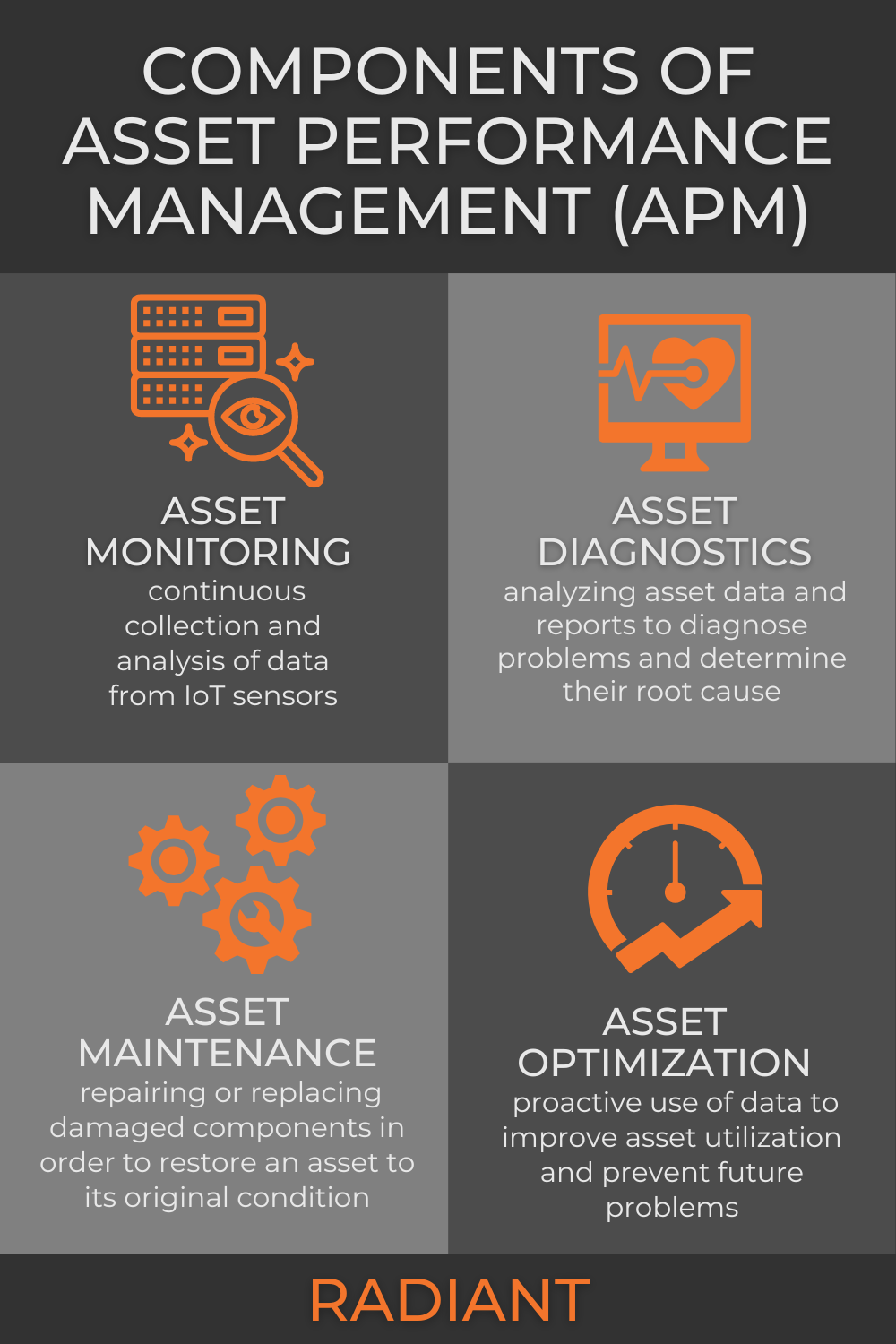When it comes to making sure your company’s critical assets are performing as they should, you need a reliable and effective way to manage them. That’s where asset performance management (APM) comes in.
But what is asset performance management, exactly? And how can it help your business in managing assets?
In this post, we’ll answer those questions and more, so you can decide if asset performance management software is right for your business.
What is Asset Performance Management?
Asset performance management (APM) is a strategy used by businesses to optimize the performance of their physical assets, such as equipment, vehicles, returnable containers, and buildings.
The goal of asset performance management is to reduce downtime, improve asset reliability, and ultimately, extend the useful life of the asset.
By investing in asset performance management software, businesses can improve their bottom line by reducing operating costs and increasing efficiency.
How does Asset Performance Management Work?
Asset performance management is a holistic approach to managing the performance of physical assets throughout their lifecycle. It takes into account all aspects of asset health, including condition, reliability, maintainability, and safety. Asset performance management uses data-driven analysis to identify potential issues and optimize asset performance.
The goal of APM is to optimize asset utilization and prevent asset failures. APM relies on four main components: asset monitoring, asset diagnostics, asset maintenance, and asset optimization.

- Asset Monitoring is the continuous collection and analysis of data from sensors and other sources. This data is used to identify trends and potential problems with an asset.
- Asset Diagnostics is the process of analyzing data and reports generated from asset monitoring to diagnose problems and determine their root cause.
- Asset Maintenance is the act of repairing or replacing damaged components in order to restore an asset to its original condition.
- Asset Optimization is the proactive use of data from asset monitoring and asset diagnostics to improve asset utilization and prevent future problems.
APM is a complex system that relies on all four of these components working together.
For example, data from asset monitoring can be used to identify trends that may indicate a need for asset maintenance or asset retirement. This data can then be passed on to the asset maintenance team, who can use it to plan future repairs.
Similarly, data from asset monitoring can be used by the asset optimization team to improve the design of future products or make changes to existing production processes.
By integrating all four components, APM provides a comprehensive approach to improving asset performance.
What are the Benefits of Asset Performance Management?
An asset performance management system can bring a number of benefits to an organization, including but not limited to:
- Greater Visibility Into Asset Performance: One of the primary benefits of asset performance management is that it provides greater visibility into the performance of an organization’s assets.By tracking data on asset utilization, maintenance, and repair history, asset performance management software gives organizations a comprehensive view of how their assets are performing. This information can be used to identify trends and make decisions about how to improve asset performance going forward.
- Improved Decision Making: Asset performance management provides organizations with the ability to make better-informed decisions about their high-value assets. Asset performance management software collects data from a variety of sources, including IoT sensors, equipment logs, and maintenance records. This data can provide valuable insights into the performance of an organization’s assets, which can help asset managers to make informed decisions about how to best use those assets. Additionally, the data collected by an APM solution can be used to create models that simulate the impact of different decisions on asset performance, allowing managers to choose the option that is most likely to lead to success.
- Reduced Unplanned Downtime: Another benefit of asset performance management is that it can help to reduce downtime by providing early warning of potential problems through predictive maintenance. By monitoring asset performance in real-time, asset managers can identify issues early before asset failures cause major disruptions. Additionally, APM systems can help organizations to schedule predictive asset maintenance and repairs in a way that minimizes downtime and keeps their most critical assets running at peak efficiency until planned asset retirement.
- Cost Savings: The implementation of an asset performance management system can also help to reduce maintenance costs associated with asset ownership. For example, by tracking asset utilization data, organizations can make changes to their operations to reduce the amount of time that assets are idle. Additionally, asset performance management software can provide insights that help organizations to optimize maintenance strategies and avoid costly repairs.For example, APM systems can help organizations identify which assets require more frequent maintenance and which assets can be safely operated with less frequent maintenance so that they can spend money where it is most needed.
- Increased Safety: Asset performance management can also help to increase safety by providing information that can help organizations to identify and resolve potential safety hazards before they cause accidents. For example, APM systems can monitor vibration levels and temperatures to identify potential problems before they cause accidents or injuries. Additionally, APM data on past incidents can be used to create safety procedures and protocols that can help to prevent accidents and injuries from occurring in the first place.
- Enhanced Collaboration Between Asset Owners and Operators: Another benefit of asset performance management is that it enhances collaboration between asset owners and operators. In many organizations, there is a disconnect between those who own assets and those who operate them on a day-to-day basis. This disconnect can lead to a lack of communication and coordination between the two groups, which can impact asset performance. APM systems can help to bridge this gap by providing a platform for asset owners and operators to share data and work together to improve asset performance
- Environmental Sustainability: Finally, APM can also have environmental benefits by helping organizations to reduce their energy consumption and emissions. For example, APM systems can provide information that helps organizations to optimize their production processes in order to reduce energy consumption and emissions.
As a result, asset performance management can offer a wide range of benefits to organizations across a variety of industries.
To receive a monthly newsletter highlighting our newest and most popular blogs, sign-up below.
Applications of Asset Performance Management Across Industries
APM is being increasingly adopted across a range of asset-intensive industries, as organizations seek to optimize asset utilization and improve overall asset performance.
Manufacturing businesses are particularly well-suited to APM, as the nature of their operations often means that they have large numbers of complex assets. By applying APM principles, manufacturers can reduce downtime, improve quality and boost productivity.
The energy, oil, and gas industry is another sector where APM is proving valuable, as it helps asset owners to monitor the performance of critical equipment in remote and hostile environments.
In the aerospace industry, meanwhile, APM is being used to manage the highly complex asset networks associated with aircraft fleets.
APM is also gaining traction in the public sector, as government agencies strive to improve asset utilization and deliver better value for taxpayers’ money. For example, in the United States, APM principles are being applied to the management of public infrastructure assets such as roads, bridges, and water treatment facilities.
In summary, Asset Performance Management is a proven approach that can bring benefits to organizations across a wide range of industries.
The Future of Asset Performance Management
The field of asset performance management is always evolving, and new technologies are constantly emerging that have the potential to change the way APM is practiced.
In recent years, the use of predictive analytics and machine learning has become increasingly common in APM, and this trend is likely to continue in the future. As data becomes more readily available, these tools will allow APM professionals to identify problems before they occur and take steps to prevent them.
In addition, the use of digital twins is also becoming more widespread. By creating a virtual model of an asset, APM professionals can test different scenarios and identify potential issues before they arise.
These are just some of the trends that are shaping the future of APM. As the field continues to undergo a digital transformation, asset managers will need to keep up with the latest technologies and trends to ensure that their assets are performing at their best.
Ready to Improve your Asset Performance?
Asset performance management is a strategic approach to managing and optimizing an organization’s assets. APM begins with understanding the performance of each individual asset and maximizing its value across the enterprise.
By monitoring, measuring, and analyzing all aspects of an asset’s life cycle, from acquisition to disposal, organizations can improve their bottom line while ensuring safety and compliance.
Implementing asset performance management solutions may seem like a daunting task, but by breaking the process down into smaller steps and applying it gradually, businesses can see real benefits in terms of efficiency, profitability, and sustainability.
If you’re ready to take your business’ assets to the next level, please explore our asset management solution and request your demo below.
Are you ready to learn more? Request a demo.
Last Updated on September 26, 2022 by Radiant

